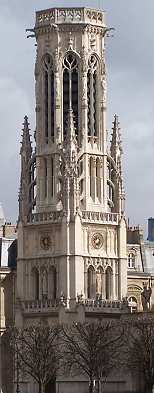1st arrondissement, Paris Pagesmore of the 1st, Click here for Louvre |
|
 |
Jardin du TuileriesThe Jardin du Tuileries, left, seen from the Carrousel just outside the Louvre looking towards the obelisk in Place de la Concorde in the 8th and onwards to the Arc du Triomphe. This formal French-style garden covers 25 hectares, and was first laid out in 1564 in front of the then Tuileries Palace. Later it was redesigned by Le Nôtre, one of France's most famous gardeners in the 17th century, for Louis XIV. It has always been a very popular public garden. Children still come here to sail boats on the ponds, and the locals and tourists make good use of the numerous chairs. The Tuileries get their name from the two tile (tuile in French) factories that were previously located here. |
The gates of the Tuileries (right) leading from Place de la Concorde are beautiful in their own right, and match the splendour of the Place. The rue de Rivoli runs along the outside of the Tuileries and is home to two good English-language bookshops, W. H. Smith's at no. 248 and Gaglinani at 224. Just out of shot, to the left in the photograph on the left, there is a stand where you can buy sandwiches and crepes. The crepes are inexpensive and delicious on a cold day after a long walk. The best hot chocolate in the worldIf you feel in need of something more substantial then you should take yourself off to Angelina's tea room for the best hot chocolate in the world. Angelina's is at 226 rue de Rivoli, next door to the Hotel Meurice. "Is Paris burning?"This hotel was used by General Dietrich von Choltitz as his HQ during the German occupation in WW2. Though the |
 |
 |
general was descended from generations of Prussian military men, and had been chosen for the job of commanding Paris by Hitler because Hitler felt Choltitz would obey orders to the letter and with alacrity, as he had done in the past. Choltitz, for once, prevaricated. He did give the order for all buildings, bridges, and monuments to be planted with explosive devices ready to be detonated, but he made sure the order to detonate was never given. And so the Allies reached and liberated an intact Paris. It is said that an incesced Hitler telephoned him and shouted, "Well, is Paris burning?". So as you stroll around Paris remember to whom you owe all this to. That Paris did not have her heart blown up like poor old London was due to a German general disobeying a direct order from Hitler. Choltitz died in Germany in 1966, and his funeral was attended by a few high-ranking French army officers, so at least some of them remembered. And speaking of burning, the normally peaceful Tuileries hosted a burning German Tiger tank complete with charred bodies on the 26 of August 1944. It was during this week that the resistance members fought to liberate Paris. In the time that followed the number of people claiming to be in the resistance multiplied hugely, however the names of those who fell that week are remembered by little plaques all over Paris bearing their names and the date. And thankfully these are covered in flowers every August, so they are still remembered today. Place VendomeRight is the column in the Place Vendome. Place Vendome is the home of all the top jewellers in Paris, as well as the Ritz Hotel. Originally there was a statue of Louis XIV in the middle of the Place, but this was destroyed during the revolution. Then Napoleon had this bronze covered column put up. |
 |
 |
The statue on the top of the column has been changed many times, there have been two of Napoleon, one of Henri IV, and a huge fleur de lys, the current statue of Napoleon has been there for over 100 years, so perhaps will stay for a while longer. The statue of Joan of Arc (above left) in Places des Pyramides outside the Louvre. The statue by Fremiet has become a shrine for the extreme right. Left is St. Germain l'Auxerrois, it faces the back of the Louvre, and is truly beautiful, but often overlooked because all the attention falls on its much larger and more well-known neighbour. Grand Admiral Gaspard ColignyOn the right is a statue of Grand Admiral Gaspard Coligny, a war veteran, leading Hugenot, statesman, and one of the most prominent Protestants in France. He was murdered in the Saint Bartholomew's Day massacre of 1572. Then his dead body was mutilated and castrated by a mob of children. If that were not enough what was left of him was strung up and left to rot. When King Charles IX and his entourage rode past the body some weeks later it smelled so bad that the courtiers covered their face with handkercheifs, however Charles said, "The body of a dead enemy never smells bad." |
 |
 |
copyright2003-2012 |



